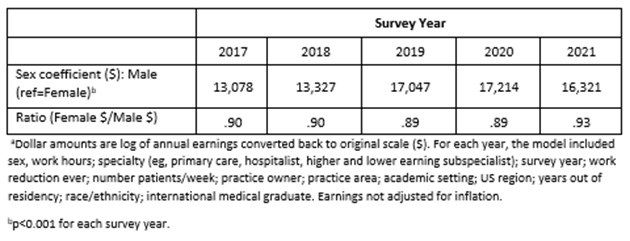Frintner M, Freed G, Byrne B, Starmer A, Olson L
Presented at the 2023 Pediatric Academic Societies Annual Meeting
Background: Prior research found that in 2016 female earned less than male pediatricians after adjustment for key factors. It is unclear if this trend has continued and if earnings reported across time change differently for female and male pediatricians.
Objective: Using 5 years of longitudinal survey data (2017-2021), examine self-reported earnings for female and male pediatricians and if earnings change over this time period by sex.
Methods: Data from a national cohort study, AAP Pediatrician Life and Career Experience Study (PLACES) used to examine pediatrician-reported earnings, 2017-2021. ANOVA tested for unadjusted differences in earnings by sex. To estimate adjusted differences in earnings between female and male pediatricians, for each survey year, we conducted a regression model using the log of annual earnings (not inflation-adjusted). In addition to sex, the model included work hours; specialty (primary care, hospitalist, higher and lower earning subspecialist); year; work reduction ever (not working or parttime on 1+ surveys); number patients/wk; practice owner; practice area; academic setting; US region; years out of residency; race/ethnicity; international medical graduate. We present the sex coefficient converted back to the original scale and ratio of female to male estimated earnings. Mixed effects regression for longitudinal analysis examined if logged earnings changed across survey years at a different rate for female and male pediatricians.
Results: 74% identify as female. Across 2017-2021, most male (95%+) and 3 in 4 female pediatricians reported >30 weekly work hours each year. Overall unadjusted mean annual income in 2021 was $228,000. Among pediatricians working >30 hours, the mean varied by sex: $231,000 for female and $269,000 for male, p<0.001.
Adjusting for key characteristics including specialty and work hours, a sex effect was found each year, with male pediatricians’ estimated earnings higher than female, p<0.001 (Table). Male estimates ranged from 11k to 17k higher across years. Female to male estimated earnings ratios ranged from 89% to 93%. Mixed effects regression found that pediatricians estimated earnings increased across years, from 2017 to 2021 (Coefficient=0.03, p<0.001) and no significant difference in rate of increase by sex (Coefficient=-0.003, p=0.66).
Conclusion: A longitudinal study found male pediatricians consistently report annual earnings ~$15,000 higher than female across 2017-2021, adjusting for key variables such as specialty and work hours. Reported earnings increased across years and the rate of increase was similar for female and male.
Table 1. Female-male pediatrician logged annual earnings gap, adjusted by pediatrician characteristics using regression

Last Updated
05/22/2023
Source
American Academy of Pediatrics